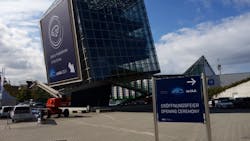HANNOVER, GERMANY. Held every two years, the IAA commercial vehicle show filling the enormous trade fair grounds here has become the global showcase for emerging truck technologies. Although it's only the show's first press day, a clear theme has alreay emerged -- the autonomous, or self-driving truck is coming.
First, there was Daimler Truck's splashy party to introduce its Future Truck 2025 . With Daimler Truck head Wolfgang Bernhard behind the self-steering wheel, it rode into an airport hanger converted for the night into a dinner venue for some 500 international press representatives.
Designed to be as visually impressive as it is technologically, the concept tractor-trailer combination integrates existing safety and control systems such as active braking, lane-departure monitoring, automated transmission with forward view mapping, and mirror-cameras into a single system that has already been demonstrated driving autonomously on a German highway at speeds up to 80 kmh. Forward and marker lighting is all LED and all hidden beneath the truck's paint, only shining through when activated. Once underway, the driver can swivel their seat 45 degrees away from the steering wheel to stretch out, take care of recordkeeping or just relax.
Next to highlight autonomous technology was Continental, which in addition to its original tire operations has become one of the world's largest providers of automotive electronics. Like Daimler, Continental is building its self-driving technology on advanced active safety systems, in this case its radar and camera based monitoring systems. At IAA it unveiled plans to add 3D mapping and advanced V2V and V2I communications to create Dynamic eHorizon, a predictive cruise control system also aggregates traffic and other information from communication vehicles. Working with OEM partners, Continental said its goal was to allow fully automated driving by 2025, the same deadline set by Daimler.
WABCO Holdings is using IAA to introduce a new version of OnGuard, the automated collision mitigation system sold in the U.S. since 2008. OnGuardPlus can bring a vehicle to a complete stop when it detects either a slow moving or stationary object. It is also updating its OnLane lane departure warning system to include drowsy driver detection. The new function could be retrofit to existing OnLane systems, which are currently sold in the U.S., according to WABCO officials.
Any fully or semi-autonomous truck of the future will have such smart braking systems as core to their techology, according to Jacques Esculier, WABCO chairman and CEO. Also introduced at IAA was new modular braking system that will allow OEMs to use common components and software to build either ABS or EBE (electronic braking systems) for particular markets, making creation of such advanced braking systems more practical, he said.
Rounding out the first morning's press conferences was PACCAR's DAF Trucks, which introduced its own predictive cruise control. Combined with new predictive shifting for its AT Tronic 12-sp. automated manual transmission, the system will bring an immediate benefit of reduced fuel consumption as well as lay the foundation for next generation self-driving models, the company said.
About the Author
Jim Mele
Jim Mele is a former longtime editor-in-chief of FleetOwner. He joined the magazine in 1986 and served as chief editor from 1999 to 2017.
